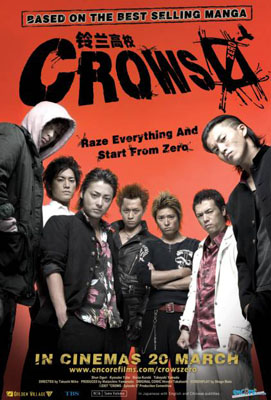With pitch-black plumage and a petrifying cry, the crow is a menacing bully, especially in Tokyo. According to crow observation logs, they attack people “from behind, kicking or pecking at the victim’s head”.
In Crows Zero, high school boys wear monochromatic black clothes, spike their hair into intimidating sculptures and adopt a similarly arrogant, threatening glare. They attack people from any direction, kicking and punching every vulnerable body part of their victims.
If you’re not a manga fanatic, Crows Zero is a film based on Crows, a manga by Japanese manga artist Hiroshi Takahashi.
However, fans of Crows needn’t despair; unlike films such as Death Note 2, this film doesn’t butcher the manga by leaving out details and modifying the plot. In fact, according to production notes, Takahashi refused numerous requests to repurpose his manga for a film because he knows how many works have been destroyed in such a manner; he only agreed after great persuasion. An entirely new storyline is used for this film, and the manga isn’t replicated. Instead, the storyline of this film attempts to explain the origins of the manga.
The film is set in Suzuran High School, a dystopia where no semblance of conventional authority and education exists. Instead, a certain pecking order (like crows) exists where students attempt to control Suzuran by forming gangs and competing with each other. Gangs engage in bloody brawls, with the losers joining the stronger one, resulting in a dominant clique that gets larger and larger with time.
Tamao Serizawa leads the most powerful faction-Serizawa Army. His status, however, is quickly challenged by transfer student Genji Takiya, who starts off the show with a bang as he effortlessly beats up Yakuza gangsters that Serizawa had offended. After Genji succeeded in uniting 3 rivals into a coalition called GPS (Genji’s Perfect Succession), Serizawa and he spend the rest of film struggling for control over Suzuran.
The Plot
A plot motivated mainly by senseless violence can’t be expected to be impressive or strong. Conversely, it is flat and lacking the dimension it needs to either pull the heartstrings of the audience or put them on the edge of their chairs.
This is worsened by the fact that the film’s subplots are underdeveloped and, at times, incomplete. For example, the inclusion of Ruka, the only female in the film, is a mere plot device that only seem to serve as testimony to Genji’s heterosexuality rather than a key component in a romance subplot.
However, one must consider the fact that this film is a prequel to the manga; such seemingly incomplete subplots might be foundations to future plot developments in the manga and possible film sequels.
Themes
Like Royston Tan’s 15 , this film tears away the aggressive macho façade projected by gangsters, revealing their vulnerable sides and the depth of their profound emotions they have for each other.
For instance, when Serizawa Army attacked Izaki, leader of a rival gang he united under GPS, Genji almost lost his main objective-of winning control of Suzuran to impress his father-in his bid at righteous revenge. In another example, both Serizawa and Genji were visibly depressed when Tokio Tatsukawa, a mutual friend, was diagnosed with a brain tumour.
It is also obvious that, despite their violence, the characters are susceptible to traits like loyalty, determination and friendship. Izaki agreed to join Genji, even though the latter was badly beaten in a surprise attack by the former’s gang, after seeing how much Genji persevered during the fight.
Acting: Intense and Humourous
More than eye candy, the Japanese actors almost make up for the lack of dimension in the film with superb acting. (Note usage of the male noun: the same can’t be said for the unnatural acting and flat personality of Redundant Ruka.) They are so intense in their acting that Shun Oguri (Genji Takiya) was actually hit by Takayuki Yamada (Tamao Serizawa) while acting, when Oguri was too absorbed in his role to warn Yamada.
Unlike the absurd melodrama in Bangkok Love Story, a fair amount of exaggeration was worked into the film for humorous effect. The audience can’t help but to laugh at the Serizawa’s exaggerated facial expression of devastation, when Genji knocked over Serizawa’s rare winning mahjong combination to pick a fight.
The Saving Grace
Even though some fight manoeuvres resemble those from popular wrestling show World Wrestling Entertainment (WWE), fight scenes are generally well choreographed. This, coupled with apposite sound effects and superior photography direction, gives the audience a reason to watch this film without regret.
Considering the experience that director Takashi Miike has in the genre of violent film, such as the very controversial Ichi the Killer, it’s no surprise that Crows Zero has excellent cinematography. Carefully selected camera angles show off the impact and swiftness of their attacks, while the dull colours of the film emphasise grungy masculinity.
Verdict
Crows Zero is definitely a pleasure to watch but it’s not something that one would like to go through a second time. Even though manga artist Takahashi was so happy with the movie that he is looking forward to the sequel, this UrbanWire writer begs to differ.
After all, the crow took flight but it mimicked neither the majestic soaring of the eagle nor the breath-taking colours of the peacock. The crow took flight but it’s still an unimpressive raven, indistinguishable from the black shadows of the clouds in the sky.
UrbanWire gives Crows Zero 3 out of 5 stars
Movie Details
Opens: Mar 20
Movie Rating: NC-16
Running Time: 131mins
Language: Japanese with English and Chinese
Director: Takashi Miike
Starring: Shun Oguri, Takayuki Yamada

